Music Pagoda
DURING my years in Brooklyn, before moving to Flushing in 1993, I developed a keen interest in Prospect Park, which was strange because, in my youthful peregrinations both with my parents and by myself I really hadn’t thought about the big park that much. By the 1980s, though, I would take the B63 5th Avenue bus to Park Slope, and maybe enter at 3rd or 9th Street on a fall Sunday afternoon, and I’d walk the park instead of watching the Jets drop another one. After a 2 or 3-hour ramble, I would typically exit the park at the Pergola at Ocean and Parkside Avenues … and my chariot awaited…the B16 bus, which ran back to my house in Bay Ridge: as a matter of fact, it deposited me across the street from my apartment house on 6th Avenue.
My Sunday journeys took me by all the park’s well-known appointments: the Long Meadow, Nethermead, Boat House, Zoo, Lake and Bandshell, but also took me into the park’s little-traveled regions. I was once reprimanded by my friend Gerry, who I bumped into one day near Grand Army Plaza. He found me in a little-traveled lane festooned with rusted lampposts that hadn’t worked since the Taft administration. I was asking for it, wandering around in such an isolated area, and the truth is, there are some very secluded sections in Prospect and the buddy system is a good bet.
I’d also fly through the park on my bike. The thing to remember is to enter the park at Park Circle, the southwestern end of the park, and go uphill along South Lake and East Drives. It’s a tough uphill in spots, but once you pass Grand Army Plaza, you’ve got a sweet downhill ride all the way back to Park Circle. Try it!
Here’s a few Forgotten Prospect Park assets. Take along The Complete Illustrated Guidebook to Prospect Park and the Brooklyn Botanical Garden, published by Silver Lining Books…worth the price alone for its incredibly detailed maps.


ACANTHUS COLUMNS, BARTEL-PRITCHARD SQUARE
Bartel-Pritchard Square, on Prospect Park’s western edge, is the dividing point between Park Slope and Windsor Terrace and a former major trolley interchange. Here was the old Sanders Theater, which existed in ghost form when I rode past it in the 1970s on the way home from college; the theater was given new life, and 7 extra screens, as the Pavilion Theater in the 1990s (I saw the “Independence Day” premiere here in 1996). Bartel-Pritchard isn’t really a ‘square’ at all: it’s a traffic roundabout in the British tradition. It was named for two local residents, young American soldiers, Emil Bartel and William Pritchard, who were killed in France in 1918 during World War I combat. Another roundabout, more logically named Park Circle, is at the park’s southwestern entrance at Parkside Avenue, Ocean Parkway and Coney Island Avenue (see below).
At Prospect Park’s entrance at Bartel-Pritchard you will find two massive columns. Inspired by the 400 B.C. Acanthus Column of Delphi, they feature granite acanthus leaves around the columns and on the capital, topped by bronze lanterns. They were designed by Stanford White in 1906, shortly before he was shot and killed by Harry Thaw: White had cheated on his marriage in a dalliance with chorus girl Evelyn Nesbit, whom Thaw later married; Thaw killed White in a jealous rage.
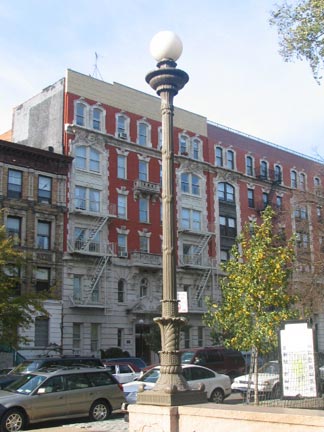

THE MARQUIS
The Lafayette Monument, a stele at Prospect Park West and 9th Street, honors the French soldier and statesman whose help was indispensable during the Revolution. It was sculpted by Daniel Chester French and unveiled in 1917. It is accompanied by two one-of-a-kind lampposts.


Prospect Park was the setting of an outright rout of American Revolutionary forces by the British, Scottish Highlanders, and Hessian mercenary troops during the Battle of Brooklyn early in the morning of August 27, 1776. A rag tag group of volunteer soldiers, many of them teenagers, were dug in on a hill in what is now the eastern section of Prospect Park south of Grand Army Plaza, along today’s East Drive just north of the Zoo, waiting for what was then the world’s mightiest fighting force to approach them. But British General Henry Clinton devised a plan of attack that would sneak up behind the colonists and take them by surprise. Completely flummoxed, those colonists not shot or bayonetted fled “Battle Pass” toward the Old Stone House at Gowanus Creek. There, a brave Maryland regiment stood their ground and helped many of the Americans to flee.
WHAT BRAVE FELLOWS
The Maryland Monument is on the other side of Lookout Hill from Friends Cemetery; climb the hill for a panoramic view of the nearby Nethermead, especially in winter. You will find the monument at the bottom of a staircase leading down from the hill.
At one time, a carriage road ascended the hill, which figured in some grandiose plans of Olmsted and Vaux: a stone observation tower, carriage court and refreshment pavilion were on the drawing board, but a financial ‘panic’ in 1873 caused the plans to be shelved. The hill today is a haven for migratory birds and butterflies.
The Maryland Monument, a simple granite shaft with a sphere at its apex designed by Stanford White, is at the foot of Lookout Hill at the bottom of a staircase along Wellhouse Drive in a relatively inconspicuous area. It is a tribute to the Maryland regiment under Lord Stirling who occupied the British long enough to allow colonial forces to slip past them at the Old Stone House, which has been restored and stands in John J. Byrne Park between 3rd and 5th Streets and 4th and 5th Avenues. It was erected August 17, 1895, at about the 119th anniversary of the Battle of Brooklyn, in honor of the Maryland regiment who aided the Americans. Like many monuments, it fell into neglect and disrepair during the late 20th Century, but was restored with assistance from the state of Maryland in 1991. The base is inscribed with the name of Brooklyn’s mayor in 1891, Charles Schieren.
Observing the battle with a spyglass from today’s Cobble Hill, George Washington is reputed to have said of the colonial forces, “what brave fellows I must this day lose.”
The main remnant of the battle today is the park’s topography. Except for East Drive, this heavily wooded part of the park looks much as it did that day in 1776. Two markers along East Drive just north of Prospect Park Zoo point out the sites of the rebel defenses and Valley Grove House, a tavern that stood near the battle site.
Another monument, marked with an eagle, indicates the spot where colonists felled a large white oak tree across the old Flatbush Road in a futile attempt to stop the onrushing British forces.

Lookout Hill as seen from across Prospect Park Lake
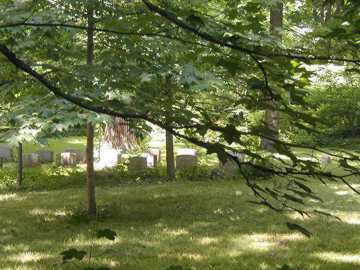
Near the park entrance at Prospect Park Southwest and 16th Street along Center Drive opposite lookout Hill you will find a cemetery that was established by the Society of Friends before Prospect Park was built. The cemetery was originally loacted between 11th and 12th Avenue and 9th and 14th Streets, which were demapped in 1866; by agreement, the Society retained the southern two-fifths of the burial ground. Burials here date as far back as the 1820s. The park was simply built around the cemetery and no trace now remains of the cross streets that surrounded it.
Actor Montgomery Clift (1920-1966) is buried here. Clift, a great friend of Elizabeth Taylor, starred with her in A Place in The Sun (1951) and Suddenly Last Summer (1959). He was nominated for Best Actor for The Search (1948), Sun and From Here to Eternity (1953). Clift was plagued by alcoholism and health problems for much of his career, and died of a heart attack in 1966. Clift’s simple gravestone at Quaker Cemetery was purportedly designed by John Benson, who designed John F. Kennedy’s at Arlington National Cemetery. An Omaha native, Clift lived in a Manhattan brownstone in the years before his death.
You will find Friends Cemetery locked behind a gate as a rule, and it is inconspicuous in a wooded area off Center Drive. There are no ostentatious stones or tombs per Quaker custom… just headstones.

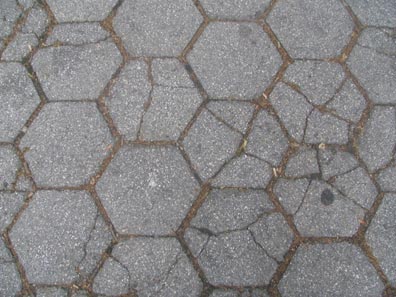
Walking west on Wellhouse Drive from the Maryland Monument, you are soon within view of Prospect Park Lake, but note the small stone-and brick structure on your right. It is the Prospect Park Well House, built in 1869, that once housed engines and machinery that once pumped 750,000 gallons of water a day into a reservoir that fed the park’s gullies, springs and lakes. The water source was a well some 70 feet deep and 50 feet in diameter directly under where you are standing, if you are facing the wellhouse. A smokestack 60 feet tall was affixed to the back of the building. After city water entered the park, the reservoir and smokestack were torn down in the 1930s, and the well was covered over, though it’s still down there. Today the wellhouse is probably the most ignored of Prospect Park’s older structures; it didn’t share in the various reconstructions and reappointments many of the park’s other buildings enjoyed in the 1990s and early 2000s.
In the 1880s in the vicinity of the wellhouse and nearby Terrace Bridge was a kiosk containg a camera obscura, a dark chamber on which an image reflected from a revolving mirror in the roof was projected on a flat white table. The camera obscura lasted only a few years, however.
Prospect Park, and indeed most New York City parks, employ special sidewalks on their exteriors and on some park walks consisting of interlocking hexagonal blocks, that can be hard to walk on at times. Most likely, they are there to accommodate tree roots; when roots interact with the usual concrete slab sidewalks, the sidewalks lose the battle and split, making for dangerous walking conditions.


above: rustic shelter; Falkill in the Ravine
Prospect Park’s answer to Central Park’s Ramble, the Ravine is an entirely artificial, planned construction, though its waterfalls, forests, and timber and rock bridges so seamlessly meld together as one that deep within its expanse you wouldn’t know you were in Prospect Park at all, but in a national park setting (except on Sundays when the Congo Square Drummers are performing in Drummers’ Grove near the Parkside entrance…the noise reverberates through fully half the park and can be heard even here!).
The Ravine is accessed from a number of entrances from the Long Meadow on the north and Nethermead on the south, via the timber Esdale Bridge and stone Nethermead Arch, which is the only bridge in Prospect Park that spans a park path, a bridle path and a waterway. The Ravine is dissected by the Ambergill Falls. Its source is an artificial spring near the base of Quaker Hill that becomes the Falkill, Ambergill, Binnenwater, and Lullwater, emptying into Prospect Park Lake at Wollmann Rink. The park’s architects originally constructed waterfalls in the park in the 1860s but erosion and neglect eliminated them until the 1990s when park management restored them to glory.


Before reading about Prospect Park and getting an idea where everything was, I would occasionally wander around in the Ravine on a ‘voyage to discovery’ in which I would get completely lost. I realized that an exit was nearby, but I didn’t know what was around the next bend, so I was in uncharted territory. I was amazed on these journeys to bump into some of Prospect Park’s least-remarked upon constructions: two rock bridges. The smaller, Rock Arch Bridge, spans Ambergill Falls while the larger, Boulder Bridge, can be found up a flight of stairs from Rock Arch, passing a rustic shelter built in the 1990s reminscent of the ones in Central Park on the site of Prospect Park’s former Dairy.
Boulder Bridge can only be truly appreciated from the bridle path, so if you ride, rent a nag from Kensington Stables on Caton Place and East 8th Street, or do what I did and walk down the bridle path under the bridge and see it from there. This is a very isolated area of the park, so be careful. While enjoying the Ravine, be mindful that in the 1980s, it had been completely ruined from lack of maintenance and questionable safety practices, and only a concerted, ongoing $43 million restoration effort on the part of the Prospect Park Alliance has brought it back. Though most of the Ravine is now restored, the project is still ongoing until the 2010s, at which time it will probably be time to begin restorations all over again.
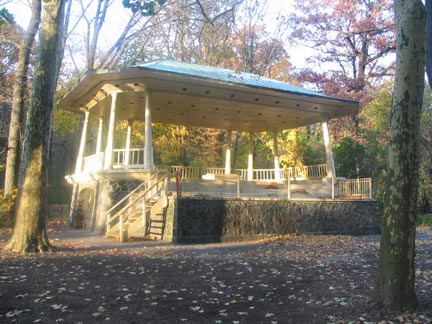

From the Ravine follow the park path under the Nethermead Arch. Note the trefoils (three-lobed designs resembling shamrocks) on the railing. You will see the second of Prospect Park’s two lengthy meadows, Nethermead, before you. The path takes you past the new timber bridge spanning Binnenwater, which flows south from Ambergill Falls under Nethermead Arch.
You have arrived at the Music Pagoda, an octagonal-shaped structure originally built in 1887 of rocks and boulders that were removed from Sullivan Hill, which lies east of the Ravine along Long Meadow. The flared roof is supported by 10 narrow slanted posts set in groups of two and three. Until the 60s, the Pagoda was a major concert and theatre venue, but it burned down in 1968 and was rebuilt 3 years later. The park’s concerts now use the Bandshell, built by Robert Moses in 1939, near Prospect Park West and 10th Street.
The pagoda is being slowly restored yet again. Another of the park’s concert venues was Music Grove, which, along with its Music Island, was not spared: it was demolished by Moses in 1960 to make way for Wollman Rink.

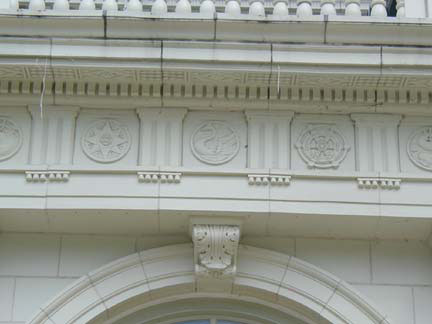
A short stroll from the Music Pagoda is a large collection of Park treasures, including the recently redeveloped Boathouse, built in 1905 by architects Helmle, Huberty and Hudswell, who also developed the Tennis House on the park’s northern end. I was taken by the triglyphs: they are of an unusual design…do they signify anything? The Boathouse was roughly based on the Library of St. Mark, a 16th century Venetian building. Note the bronze lampposts: each has a dolphin motif on the base.
The Boathouse has been given a new lease on life as the kid-friendly Audubon Science Center. Stop in and check the birdwatching exhibits, thumb through the library, even check email on one of the computers. Note the interlocking Guastavino-type tiles on the roof.
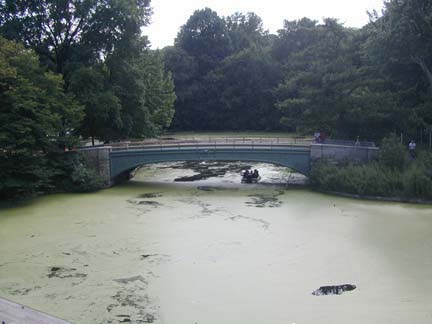

The Boathouse hasn’t forsaken its original function as a boat launch. You can catch a ride here or peddle a boat from the boat launch near Wollman Rink over here. In the view at left is Lullwater Bridge, Prospect Park’s only iron span; it was restored recently along with the Boathouse.

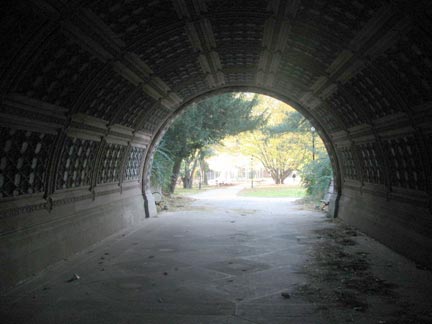
JUST LIKE TELEVISION
Cleft Ridge Span takes Wellhouse Drive over the park path near the Concert Grove, Oriental Pavilion and Camperdown Elm. Built 1871-72 of Beton Coignet concrete (sand, gravel, cement), its first use in the USA. It is the ‘newest’ and most ornate of Prospect Park’s arches (excluding iron bridges such as Terrace, above). You’ll notice three separate colors as well as an interesting relief pattern in the vault.
As in most Prospect Park’s arches, it functions as a dark tunnel through which the park’s activities can be glimpsed through a curved opening. The effect is remarkably like TV!
ORIENTAL PAVILION
I discover something new almost every time I am in Prospect Park, and until the summer of 2004, I didn’t know about the stop sign-shaped stained glass window with its 8 radiating pentagons at the Concert Pavilion’s roof. That’s because I had never thought to cast my glance skyward when walking under it. The Pavilion was completed in 1874 and consists of eight cast iron posts, painted colorfully in a vague Middle Eastern pattern, supporting a complex roof that flares outward on the edges, creating a large shady area. The Pavilion originally looked out over the adjoining Concert Grove, so parkgoers could sit under it on those hot sunny days and enjoy the brass bands. Robert Moses constructed a snack bar under the pavilion in the early 1950s, which burned down in 1974, taking the pavilion along with it, but happily, it was rebuilt in 1987. It could use a touch-up by now, however.
Directly in front of the Oriental Pavilion, down a short set of steps, is Concert Grove, a formal European-style garden designed to look out over a small island in Prospect Park Lake containing a performance stage where the popular bands of the day would play. There were large areas for carriages to park on each side of the Grove. It turned out that the acoustics weren’t the best, and concerts moved to the Music Pagoda (see above) and ultimately the Prospect Park Bandshell. As noted previously, the stage area was torn up, the island attached to the mainland by fill, and the Wollman Rink installed in its place.
However, the formal garden remains, with busts of Beethoven (looking cranky as he usually does in his portraits), Edvard Grieg (Norwegian composer of the Peer Gynt Suites and “Hall of the Mountain King”), Wolfgang Amadeus Mozart, and his cousin by marriage, Carl Maria von Weber. Crashing the composer party is Irish writer Thomas Moore, who can also be found in Central Park. With his back to the composers, looking out over the skating rink, is H.K. Brown’s massive bronze study of Abraham Lincoln. More than one writer has remarked that Abe seems to be looking wistfully at the rink, wishing the original concert area could be put back. In fact, Abe used to hold forth at Grand Army Plaza, but was removed to Concert Grove when the Soldiers’ and Sailors’ monumental arch went up in the early 1890s.
On the other side of the Pavilion on East Drive, there’s a rather incongruous bust of Washington Irving.
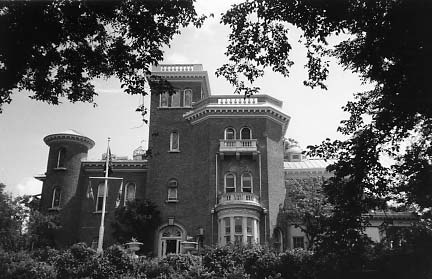
HE’S NOT MOVING
This beautiful mansion facing Prospect Park West on the park grounds at 5th Street predates Prospect Park, and predates most of the rest of the neighborhood. It was built by Edwin Litchfield, who figures so prominently in early Park Slope and Gowanus history: he built the Brooklyn Improvement Company headquarters on 3rd Avenue and 3rd Street and in great part, leveled the Old Stone House in John J. Byrne Park, which has since been rebuilt.
Litchfield Villa was completed in 1857 by architect Alexander Jackson Davis. Litchfield owned all the land from about 1st to 9th Streets and from the Gowanus Canal to about 10th Avenue. 10th Avenue? At one time, it did go through here, at least on paper, until the city of Brooklyn acquired the territory for Prospect Park, which was built around the house, much like it was around Friends Cemetery (see above). It was built in Italianate style and named Grace Hill for Litchfield’s wife. It’s a great place to walk around, picnic, and admire the ornate architecture with its arches, towers, Corinthian columns, eaves, and porch supports with carven corn and wheat motifs. Go on in, it’s open for visitors as the Brooklyn HQ of the NYC Department of Parks.
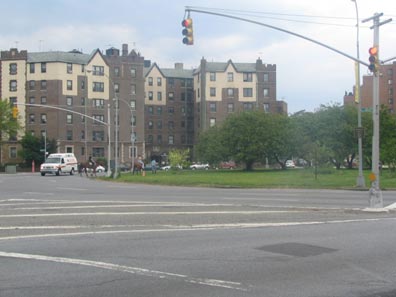
Park Circle, more properly known as P.O. Robert Machate Circle for a 25-year-old police officer killed in pursuit of a suspect in Flatbush in 1989, is a traffic circle or ’roundabout’ as they say in Britain. It was opened in 1867 at the park’s southwestern edge at the Parade Grounds. Here Coney Island Avenue and Ocean Parkway begin their long march seaward.
The striking visual impact of the twin Horse Tamers sculptures by Frederick MacMonnies greets visitors on each side of the drive leading into the park from the Circle. The sculptures, dedicated in 1899, were originally called “The Triumph of Mind over Brute Force.” Some reviewers compare it to Guillaume Coustou’s Horses of Marly in the Place del la Concorde in Paris. Note that the tamer is using a curved dagger, known as a quint, to subdue the steeds.
Can you imagine such detail and care being included in the design of, say, a bus shelter today? Yet these twin structures flanking the Horse Tamers were built as horsecar shelters by Stanford White in 1896. They feature marble benches and roof ironwork. Today they offer a cool respite from heat waves and shelter from showers.
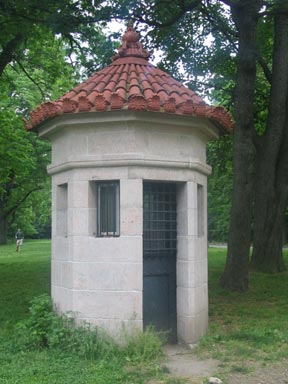
This small structure with bars on the door and windows puzzles me. It’s not a old tollhouse, though there is one at the Willink Entrance on the other side of the park on Flatbush Avenue. I suspect it’s a guardhouse: was there a private section of the park in the old days?
Perhaps they can put firecracker throwers, muggers, graffitists and other miscreants in here to cool their heels.
The park’s southern stretch also contains a couple of Forgotten nuggets. The Peristyle, also known as the Grecian Shelter, can be found on South Lake Drive, north of the newly-restored Parade Grounds. Though it looks, with its numerous Corinthian columns, as if it could have fit in in Greece in the classic era, it is actually a Renaissance-style limestone structure built by McKim, Mead and White in 1903. The Parade Grounds, which it faces, once actually featured parades, as well as military exhibitions. Its present-day athletic fields were restored and refurbished in 2004.


Facing the Parkside Avenue subway entrance at Ocean Avenue is the trellised, Ionic-columned Pergola; McKim, Mead and White also constructed this entrance a year after they finished the Peristyle. The Pergola features a granite colonnade consisting of Ionic columns split by an entrance drive. Wisteria vines climb trellises on either side. The Congo Square Drummers set up nearby on Sunday.
In the late 1980s, the Pergola entrance drive featured two of Brooklyn’s first new reproductions of the old Bishop Crook lampposts.
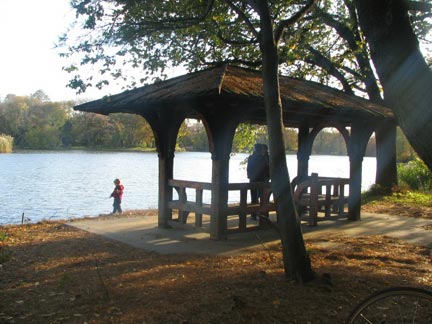
The Prospect Park Lake is decorated, like Central Park Lake, with a number of wooden rustic shelters. This one is on the Peninsula, a birdwatching and dog-run mecca roughly resembling the Italian boot, jutting down from the northern end of the Lake. In the late 1800s the Peninsula was home to two now-razed structures: the Model Yacht Club House, which stood from 1900 to 1956, and a large shelter resembling the Oriental Pavilion, built in 1915 and lasting about thirty years.
There are still a number of old lamp fixtures and signs to be found in the park, like the old-style park luminaire with the metal mesh protector to be fopund at Concert Grove. The city later swicthed to glass and plastic reflector fixtures, with predictable results. Smashed lamps were a park rule into the 1980s.
The 1950s one-way sign is juxtaposed with a 1990s directional sign on this East Drive lamppost.
Until the early 1990s park paths in the northeastern end of the park had special lamps (not the Bacon models seen throughout the rest of the park). These had a fluted design on the base and spikes surrounding the top of the lamp. They were all gone by my visit in 2004, except for this one, which has long since lost its light.

VALE OF FEARS?
The Vale of Cashmere, in the Park’s northeastern end just south of Grand Army Plaza, is a formal sunken garden at the bottom of a ravine formed by a retreating glacier. The garden takes its name from a line in Thomas Moore’s poem “Lalla Rookh”; sculptures of Moore, little-read today, can be found in both Prospect and Central Parks. The centerpiece of the fountain was a sculpture of a nude youth holding a duck surrounded by six turtles; it was stolen in 1941.
The Vale is in one of Prospect’s more secluded areas and should be approached with caution.
The Prospect Park subway station, accessible from Flatbush Avenue at Ocean and also from Lincoln Road, was first opened as an at-grade railroad station in 1907 by the Brooklyn, Flatbush and Coney Island Railroad. Its present station house dates to1920 and, like other stations on the BMT Brighton line, has a window overlooking the tracks, unusual in the NYC subway system. It presently (2005) serves the B and Q trains, though the MTA shuffles the letters every few years. Some of the station’s original bare-bulb light fixtures still work.
More on Prospect Park:
SOURCES:
Prospect Park and Brooklyn Botanic Garden, Complete Illustrated Guidebook, Neil deMause and Richard Berenson, Silver Lining 2001
Prospect Park Handbook, Clay Lancaster, Walton Rawls 1967
Photographed mostly 11/04 and 5/05, written 5/30/05

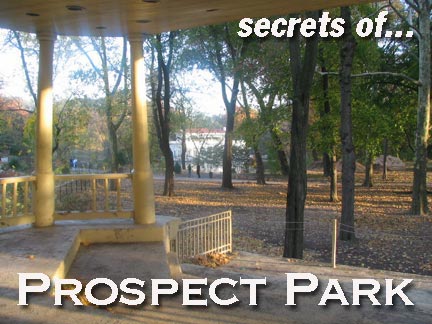
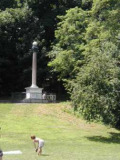
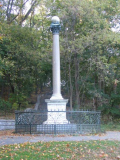
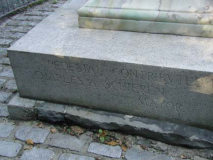
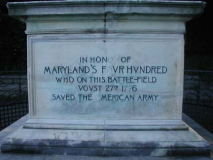
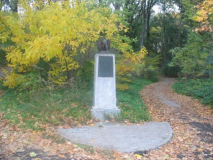
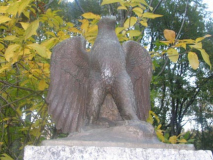
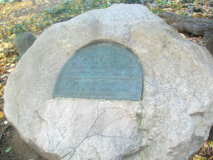

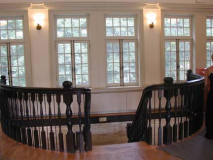
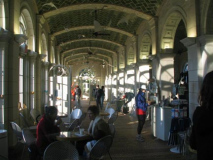
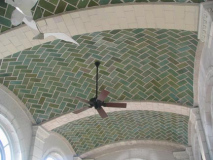
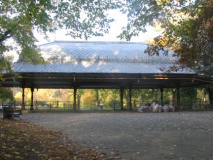
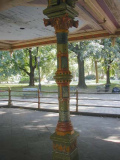
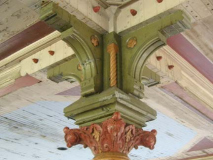
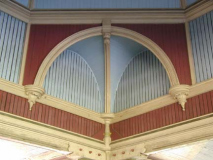
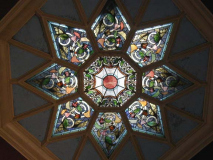
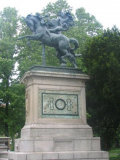
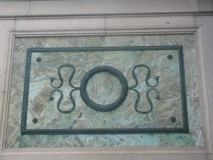
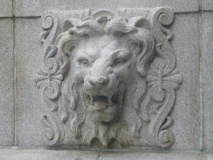
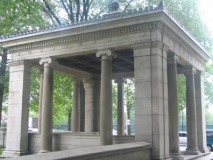

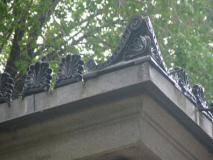
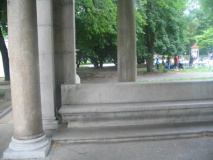
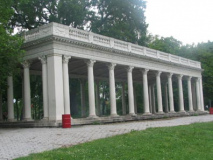
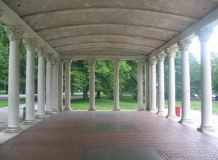
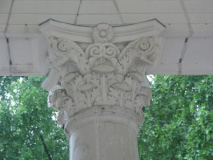

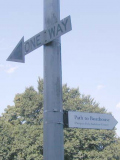
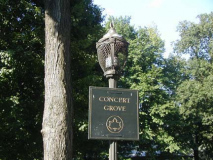
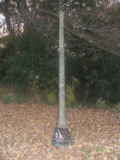
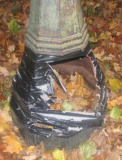
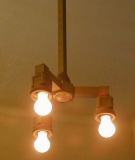
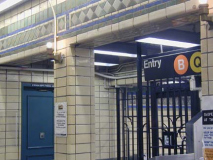
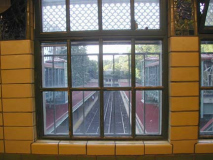
6 comments
Thanks for the memories …. Location … Hawaii for the past 40 years.
Prospect park was my escape in the big city.
Aloha
The pictures brought back a lot of memories from ice skating to pitching woo, and hanging out at BP square in the late 60’s.
What wonderful memories. I grew up on Ocean Avenue between Parkside and Lincoln and Prospect Park was my playground. Used to go sledding down Lookout Mountain; there was a playground with a slide and swings and I vaguely remember a zoo. There was a trolley car on Ocean Ave and I remember on the cold winter days we would walk down to Parkside to see if the sign was there that it was safe to ice skate on the lake. My family moved to Queens in the early l950s and I have not been back to the park since.
Enjoyed reading your comment! I live on the same street, right between Lincoln and Parkside. I didnt know there used to be a street car and that you used to be able to ice skate on the lake
the fear is bizarre, approached with caution! lol But we know what that is really about….
I grew up on Woodruff and Parade Place, right around the corner from the Park and across the street fro the Parade Grounds. I remember the twelve baseball diamonds, the bowling green and the old club house.
My friends and I were some of the first few who played tennis on the clay courts, right off park circle, when it was outdoors. The days of baseball and football are uncountable.
Ice skating, on the lake and the skating rink, sleigh riding down “suicide hill” in the winter.
Too many memories.
Thanks for this.